YAMAHA XMAX 250 2009 User Guide
Manufacturer: YAMAHA, Model Year: 2009, Model line: XMAX 250, Model: YAMAHA XMAX 250 2009Pages: 92, PDF Size: 4.7 MB
Page 11 of 92

1
SAFETY INFORMATION
1-4
nize that some aftermarket accesso-
ries or modifications are not suitable
because of potential safety hazards to
you or others. Installing aftermarket
products or having other modifica-
tions performed to your vehicle that
change any of the vehicle’s design or
operation characteristics can put you
and others at greater risk of serious
injury or death. You are responsible
for injuries related to changes in the
vehicle.
Keep the following guidelines in mind,
as well as those provided under “Loa-
ding” when mounting accessories.
●Never install accessories or carry
cargo that would impair the per-
formance of your scooter. Care-
fully inspect the accessory befo-
re using it to make sure that it
does not in any way reduce
ground clearance or cornering
clearance, limit suspension tra-
vel, steering travel or control ope-
ration, or obscure lights or reflec-
tors.
• Accessories fitted to the hand-
lebar or the front fork area can
create instability due to impro-per weight distribution or
aerodynamic changes. If
accessories are added to the
handlebar or front fork area,
they must be as lightweight as
possible and should be kept to
a minimum.
• Bulky or large accessories may
seriously affect the stability of
the scooter due to aerodyna-
mic effects. Wind may attempt
to lift the scooter, or the scoo-
ter may become unstable in
cross winds. These accesso-
ries may also cause instability
when passing or being passed
by large vehicles.
• Certain accessories can dis-
place the operator from his or
her normal riding position. This
improper position limits the fre-
edom of movement of the ope-
rator and may limit control abi-
lity, therefore, such
accessories are not recom-
mended.
●Use caution when adding electri-
cal accessories. If electrical
accessories exceed the capacityof the scooter’s electrical system,
an electric failure could result,
which could cause a dangerous
loss of lights or engine power.
Aftermarket Tires and Rims
The tires and rims that came with your
scooter were designed to match the
performance capabilities and to pro-
vide the best combination of hand-
ling, braking, and comfort. Other tires,
rims, sizes, and combinations may
not be appropriate. Refer to page
6-16 for tire specifications and more
information on replacing your tires.
1C0-F8199-E5.QXD 3/10/08 05:56 Página 11
Page 12 of 92
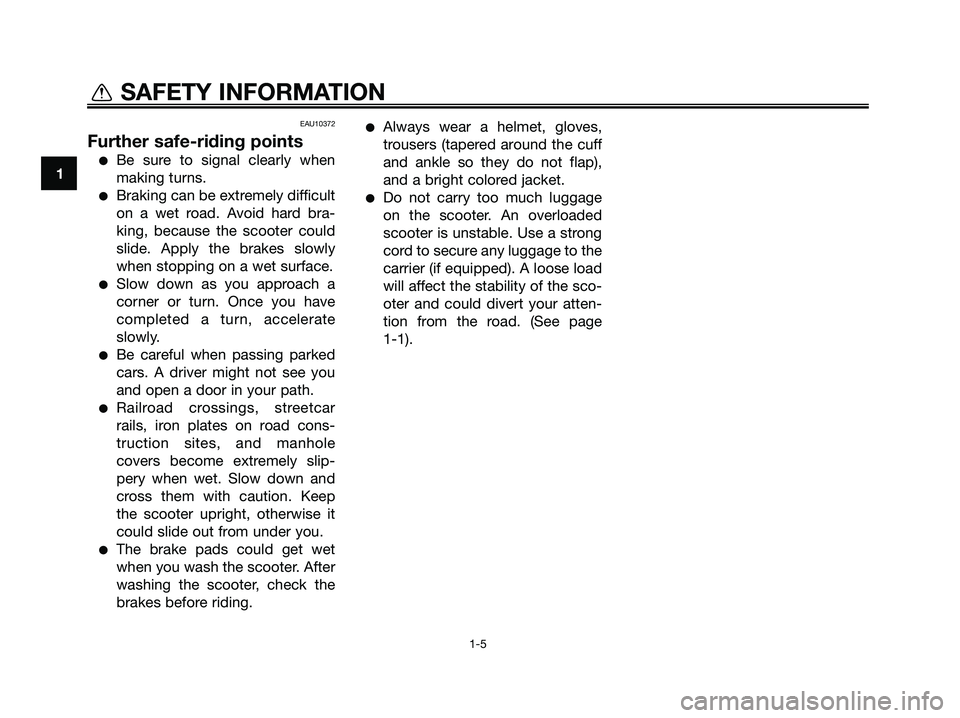
EAU10372
Further safe-riding points
●Be sure to signal clearly when
making turns.
●Braking can be extremely difficult
on a wet road. Avoid hard bra-
king, because the scooter could
slide. Apply the brakes slowly
when stopping on a wet surface.
●Slow down as you approach a
corner or turn. Once you have
completed a turn, accelerate
slowly.
●Be careful when passing parked
cars. A driver might not see you
and open a door in your path.
●Railroad crossings, streetcar
rails, iron plates on road cons-
truction sites, and manhole
covers become extremely slip-
pery when wet. Slow down and
cross them with caution. Keep
the scooter upright, otherwise it
could slide out from under you.
●The brake pads could get wet
when you wash the scooter. After
washing the scooter, check the
brakes before riding.
●Always wear a helmet, gloves,
trousers (tapered around the cuff
and ankle so they do not flap),
and a bright colored jacket.
●Do not carry too much luggage
on the scooter. An overloaded
scooter is unstable. Use a strong
cord to secure any luggage to the
carrier (if equipped). A loose load
will affect the stability of the sco-
oter and could divert your atten-
tion from the road. (See page
1-1).
1
SAFETY INFORMATION
1-5
1C0-F8199-E5.QXD 3/10/08 05:56 Página 12
Page 13 of 92
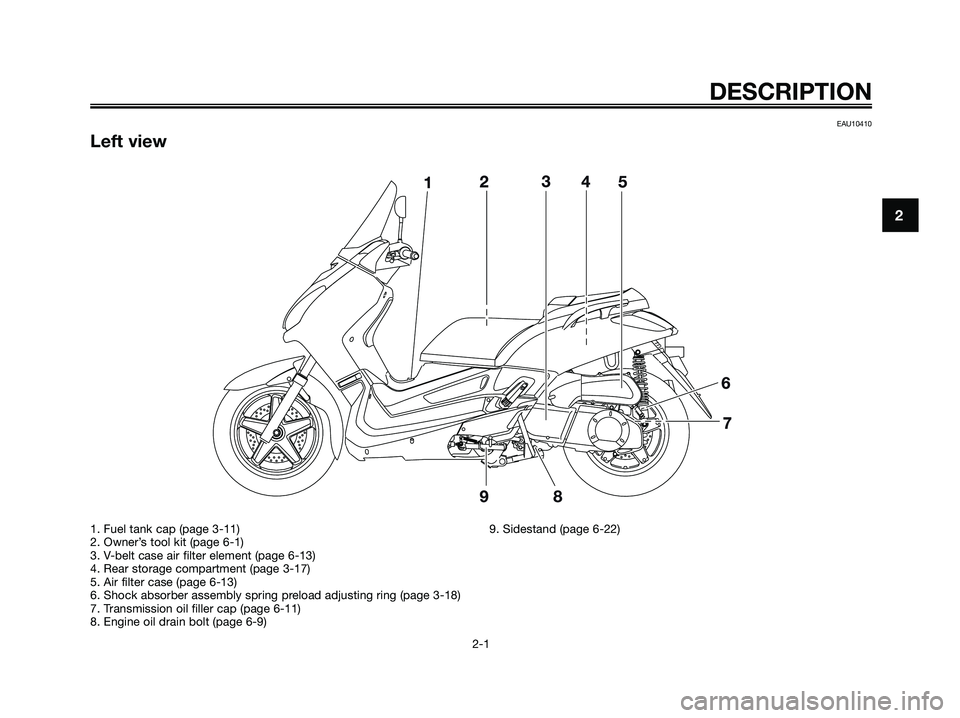
EAU10410
Left view
DESCRIPTION
2-1
2
1. Fuel tank cap (page 3-11)
2. Owner’s tool kit (page 6-1)
3. V-belt case air filter element (page 6-13)
4. Rear storage compartment (page 3-17)
5. Air filter case (page 6-13)
6. Shock absorber assembly spring preload adjusting ring (page 3-18)
7. Transmission oil filler cap (page 6-11)
8. Engine oil drain bolt (page 6-9)9. Sidestand (page 6-22)
1C0-F8199-E5.QXD 3/10/08 05:56 Página 13
Page 14 of 92

EAU10420
Right view
DESCRIPTION
2-2
2
1. Grab bar (page 5-2)
2. Seat (page 3-14)
3. Battery (page 6-24)
4. Fuses (page 6-26)
5. Front brake pads (page 6-19)
6. Coolant level check window (page 6-12)
7. Passenger footrest
8. Centerstand (page 6-22)9. Engine oil filler cap (page 6-9)
10. Rear brake pads (page 6-19)
1C0-F8199-E5.QXD 3/10/08 05:56 Página 14
Page 15 of 92
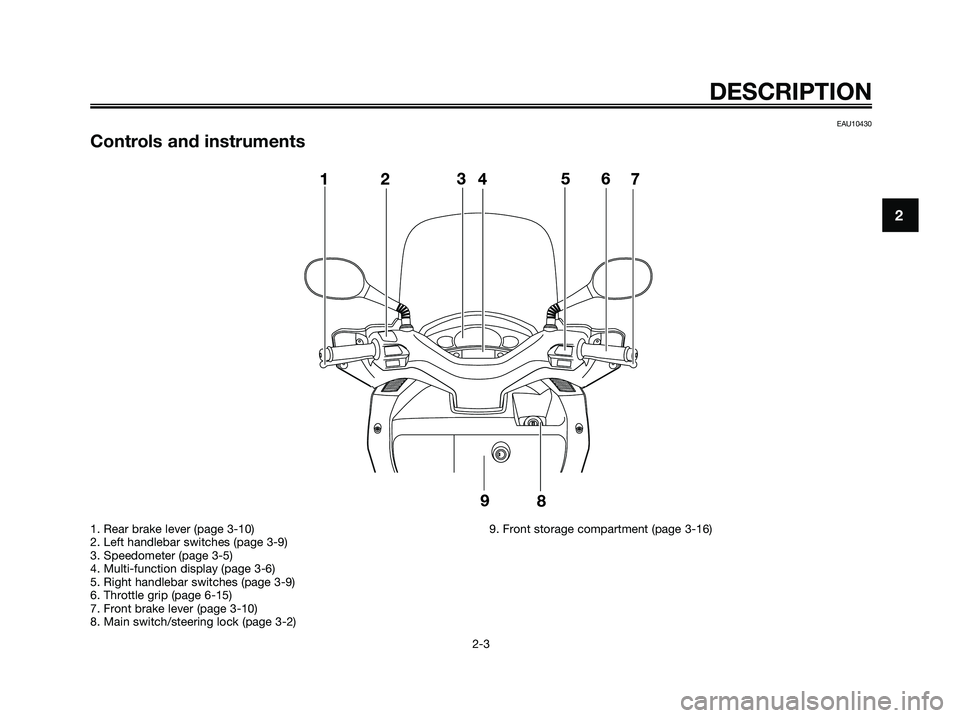
EAU10430
Controls and instruments
DESCRIPTION
2-3
2
1. Rear brake lever (page 3-10)
2. Left handlebar switches (page 3-9)
3. Speedometer (page 3-5)
4. Multi-function display (page 3-6)
5. Right handlebar switches (page 3-9)
6. Throttle grip (page 6-15)
7. Front brake lever (page 3-10)
8. Main switch/steering lock (page 3-2)9. Front storage compartment (page 3-16)
1C0-F8199-E5.QXD 3/10/08 05:56 Página 15
Page 16 of 92
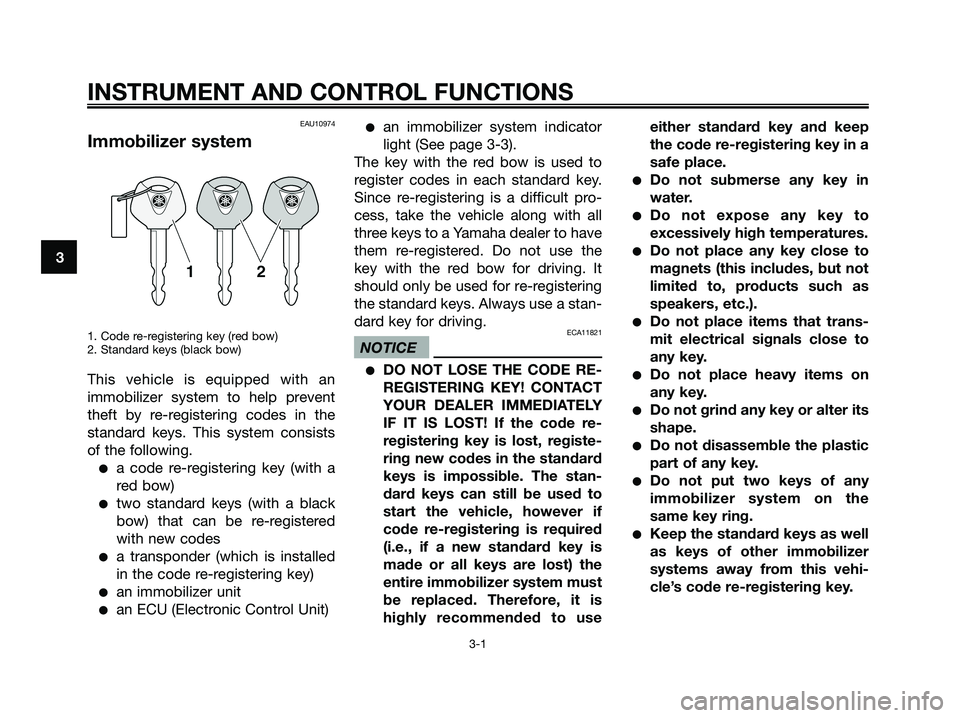
INSTRUMENT AND CONTROL FUNCTIONS
3-1
3
EAU10974
Immobilizer system
1. Code re-registering key (red bow)
2. Standard keys (black bow)
This vehicle is equipped with an
immobilizer system to help prevent
theft by re-registering codes in the
standard keys. This system consists
of the following.
●a code re-registering key (with a
red bow)
●two standard keys (with a black
bow) that can be re-registered
with new codes
●a transponder (which is installed
in the code re-registering key)
●an immobilizer unit
●an ECU (Electronic Control Unit)
●an immobilizer system indicator
light (See page 3-3).
The key with the red bow is used to
register codes in each standard key.
Since re-registering is a difficult pro-
cess, take the vehicle along with all
three keys to a Yamaha dealer to have
them re-registered. Do not use the
key with the red bow for driving. It
should only be used for re-registering
the standard keys. Always use a stan-
dard key for driving.
ECA11821
NOTICE
●DO NOT LOSE THE CODE RE-
REGISTERING KEY! CONTACT
YOUR DEALER IMMEDIATELY
IF IT IS LOST! If the code re-
registering key is lost, registe-
ring new codes in the standard
keys is impossible. The stan-
dard keys can still be used to
start the vehicle, however if
code re-registering is required
(i.e., if a new standard key is
made or all keys are lost) the
entire immobilizer system must
be replaced. Therefore, it is
highly recommended to useeither standard key and keep
the code re-registering key in a
safe place.
●Do not submerse any key in
water.
●Do not expose any key to
excessively high temperatures.
●Do not place any key close to
magnets (this includes, but not
limited to, products such as
speakers, etc.).
●Do not place items that trans-
mit electrical signals close to
any key.
●Do not place heavy items on
any key.
●Do not grind any key or alter its
shape.
●Do not disassemble the plastic
part of any key.
●Do not put two keys of any
immobilizer system on the
same key ring.
●Keep the standard keys as well
as keys of other immobilizer
systems away from this vehi-
cle’s code re-registering key.
1C0-F8199-E5.QXD 3/10/08 05:56 Página 16
Page 17 of 92
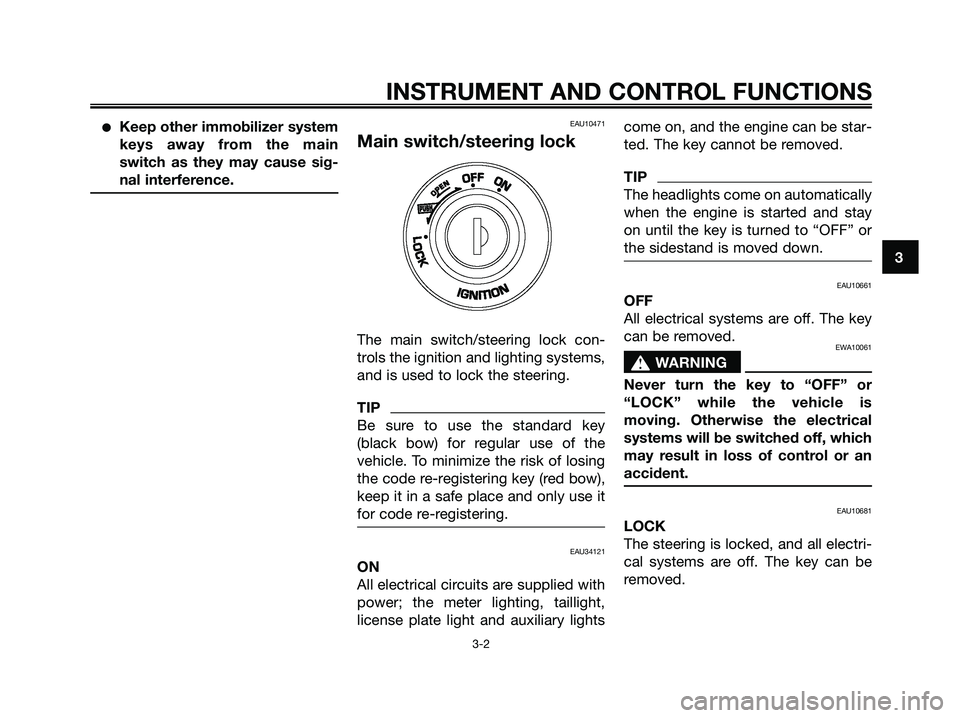
●Keep other immobilizer system
keys away from the main
switch as they may cause sig-
nal interference.EAU10471
Main switch/steering lock
The main switch/steering lock con-
trols the ignition and lighting systems,
and is used to lock the steering.
TIP
Be sure to use the standard key
(black bow) for regular use of the
vehicle. To minimize the risk of losing
the code re-registering key (red bow),
keep it in a safe place and only use it
for code re-registering.
EAU34121
ON
All electrical circuits are supplied with
power; the meter lighting, taillight,
license plate light and auxiliary lightscome on, and the engine can be star-
ted. The key cannot be removed.
TIP
The headlights come on automatically
when the engine is started and stay
on until the key is turned to “OFF” or
the sidestand is moved down.
EAU10661
OFF
All electrical systems are off. The key
can be removed.
EWA10061
s s
WARNING
Never turn the key to “OFF” or
“LOCK” while the vehicle is
moving. Otherwise the electrical
systems will be switched off, which
may result in loss of control or an
accident.
EAU10681
LOCK
The steering is locked, and all electri-
cal systems are off. The key can be
removed.
INSTRUMENT AND CONTROL FUNCTIONS
3-2
3
1C0-F8199-E5.QXD 3/10/08 05:56 Página 17
Page 18 of 92
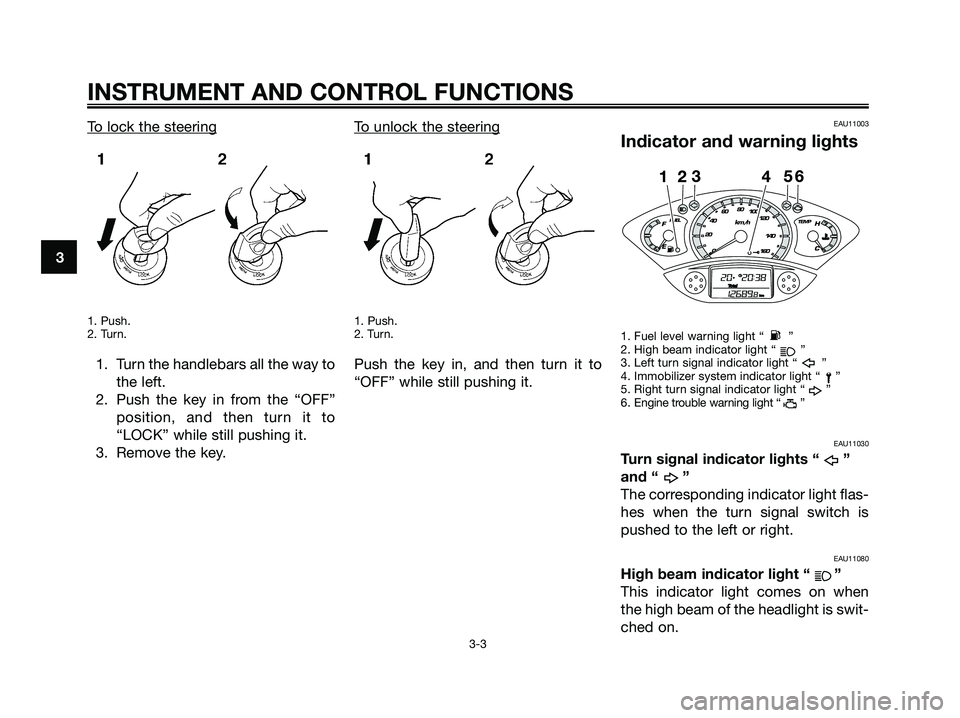
To lock the steering
1. Push.
2. Turn.
1. Turn the handlebars all the way to
the left.
2. Push the key in from the “OFF”
position, and then turn it to
“LOCK” while still pushing it.
3. Remove the key.T
o unlock the steering
1. Push.
2. Turn.
Push the key in, and then turn it to
“OFF” while still pushing it.
EAU11003
Indicator and warning lights
1. Fuel level warning light “ ”
2. High beam indicator light “ ”
3. Left turn signal indicator light “ ”
4. Immobilizer system indicator light “ ”
5. Right turn signal indicator light “ ”
6. Engine trouble warning light “ ”
EAU11030
Turn signal indicator lights “ ”
and “ ”
The corresponding indicator light flas-
hes when the turn signal switch is
pushed to the left or right.
EAU11080
High beam indicator light “ ”
This indicator light comes on when
the high beam of the headlight is swit-
ched on.
20406080
100
120
140
160km/h
0
FFUEL
EH
C
TEMP
INSTRUMENT AND CONTROL FUNCTIONS
3-3
3
1C0-F8199-E5.QXD 3/10/08 05:56 Página 18
Page 19 of 92
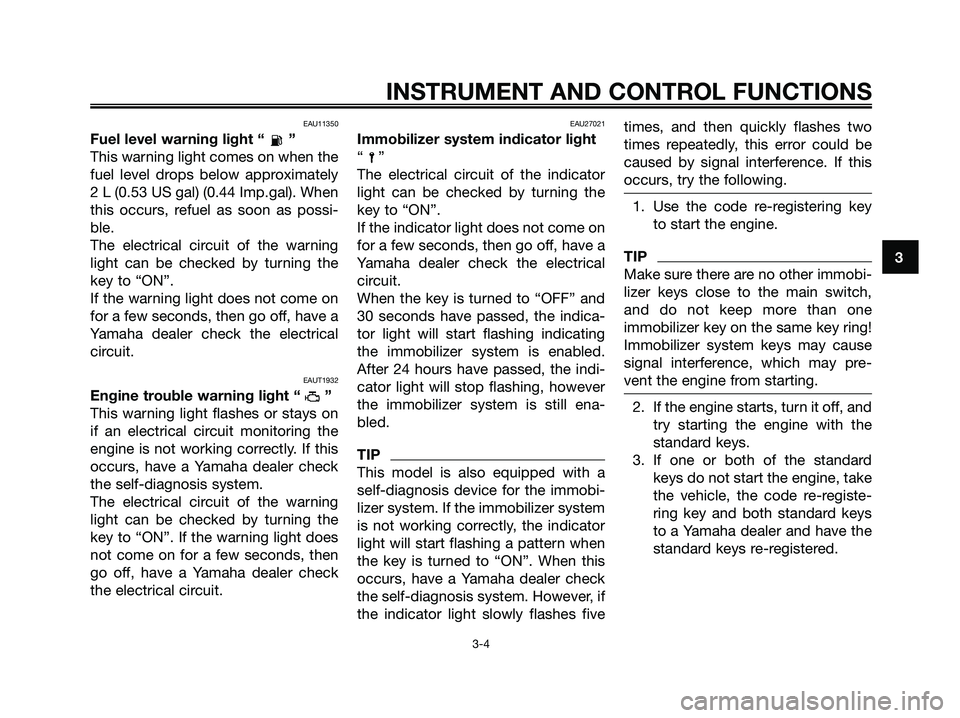
EAU11350
Fuel level warning light “ ”
This warning light comes on when the
fuel level drops below approximately
2 L (0.53 US gal) (0.44 Imp.gal). When
this occurs, refuel as soon as possi-
ble.
The electrical circuit of the warning
light can be checked by turning the
key to “ON”.
If the warning light does not come on
for a few seconds, then go off, have a
Yamaha dealer check the electrical
circuit.
EAUT1932
Engine trouble warning light “ ”
This warning light flashes or stays on
if an electrical circuit monitoring the
engine is not working correctly. If this
occurs, have a Yamaha dealer check
the self-diagnosis system.
The electrical circuit of the warning
light can be checked by turning the
key to “ON”. If the warning light does
not come on for a few seconds, then
go off, have a Yamaha dealer check
the electrical circuit.
EAU27021
Immobilizer system indicator light
“”
The electrical circuit of the indicator
light can be checked by turning the
key to “ON”.
If the indicator light does not come on
for a few seconds, then go off, have a
Yamaha dealer check the electrical
circuit.
When the key is turned to “OFF” and
30 seconds have passed, the indica-
tor light will start flashing indicating
the immobilizer system is enabled.
After 24 hours have passed, the indi-
cator light will stop flashing, however
the immobilizer system is still ena-
bled.
TIP
This model is also equipped with a
self-diagnosis device for the immobi-
lizer system. If the immobilizer system
is not working correctly, the indicator
light will start flashing a pattern when
the key is turned to “ON”. When this
occurs, have a Yamaha dealer check
the self-diagnosis system. However, if
the indicator light slowly flashes fivetimes, and then quickly flashes two
times repeatedly, this error could be
caused by signal interference. If this
occurs, try the following.
1. Use the code re-registering key
to start the engine.
TIP
Make sure there are no other immobi-
lizer keys close to the main switch,
and do not keep more than one
immobilizer key on the same key ring!
Immobilizer system keys may cause
signal interference, which may pre-
vent the engine from starting.
2. If the engine starts, turn it off, and
try starting the engine with the
standard keys.
3. If one or both of the standard
keys do not start the engine, take
the vehicle, the code re-registe-
ring key and both standard keys
to a Yamaha dealer and have the
standard keys re-registered.
INSTRUMENT AND CONTROL FUNCTIONS
3-4
3
1C0-F8199-E5.QXD 3/10/08 05:56 Página 19
Page 20 of 92
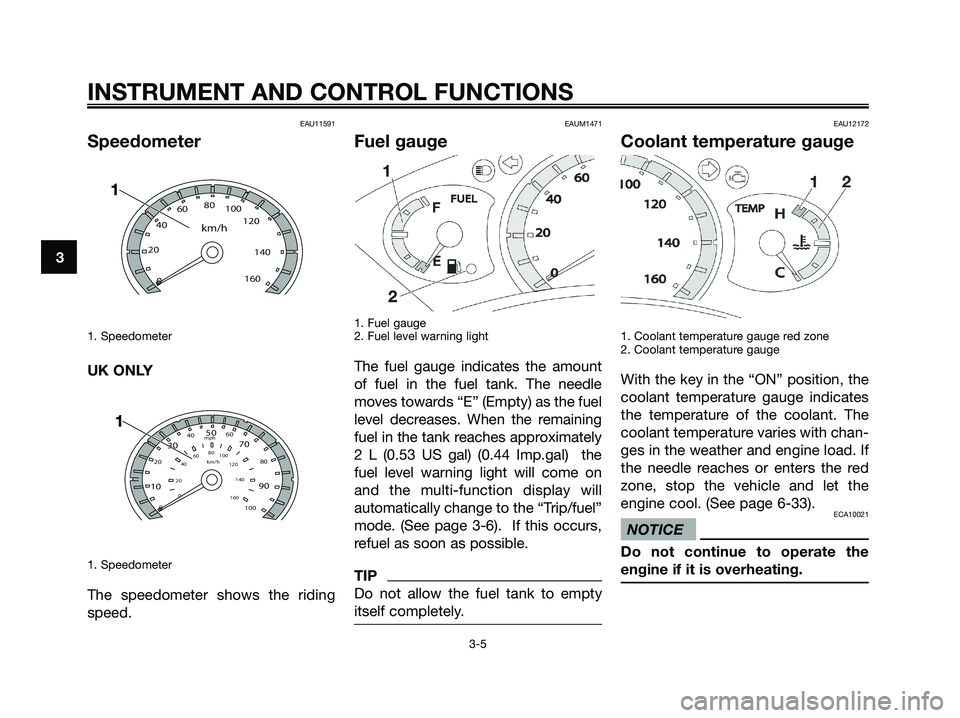
EAU11591
Speedometer
1. Speedometer
UK ONLY
1. Speedometer
The speedometer shows the riding
speed.
EAUM1471
Fuel gauge
1. Fuel gauge
2. Fuel level warning light
The fuel gauge indicates the amount
of fuel in the fuel tank. The needle
moves towards “E” (Empty) as the fuel
level decreases. When the remaining
fuel in the tank reaches approximately
2 L (0.53 US gal) (0.44 Imp.gal) the
fuel level warning light will come on
and the multi-function display will
automatically change to the “Trip/fuel”
mode. (See page 3-6). If this occurs,
refuel as soon as possible.
TIP
Do not allow the fuel tank to empty
itself completely.
EAU12172
Coolant temperature gauge
1. Coolant temperature gauge red zone
2. Coolant temperature gauge
With the key in the “ON” position, the
coolant temperature gauge indicates
the temperature of the coolant. The
coolant temperature varies with chan-
ges in the weather and engine load. If
the needle reaches or enters the red
zone, stop the vehicle and let the
engine cool. (See page 6-33).
ECA10021
NOTICE
Do not continue to operate the
engine if it is overheating.
103050
70
90
204060
80
100 0
20406080
100
120
140
160 0km/h mph
20406080
100
120
140
160
km/h
0
INSTRUMENT AND CONTROL FUNCTIONS
3-5
3
1C0-F8199-E5.QXD 3/10/08 05:56 Página 20